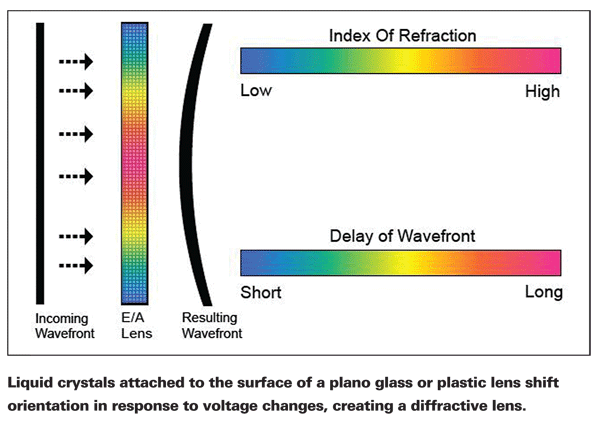Every ophthalmologist would love to see an ideal "cure" for presbyopia. Most of the current steps in that direction involve surgical options, such as implanting a multifocal or accommodative lens or altering the cornea. Ironically, the solution a child would probably suggest—eyeglasses that do your focusing for you—has seemed so much like science fiction that few have given it much thought.
Until now.
It turns out that one group of individuals have not only given it a lot of thought, they're in the process of making self-focusing eyeglasses a reality. A company called PixelOptics, headed by president and CEO Ronald Blum, OD, is well down the path to a marketable product. The company currently holds 22
Dr. Blum says the idea for this technology originated when he and colleague Dwight Duston, PhD—who ran research and development for the United States Strategic Defense Initiative, a.k.a. "Star Wars," until he left the military—decided to collaborate on technology that would allow a computer screen to focus for the user, eliminating the need for eyeglasses when working at the computer. "The viewer's prescription would be entered into the program using the mouse," he explains. "The screen would monitor your position relative to it and change focus accordingly." However, Drs Blum and Dustin eventually decided that the technology they were developing would probably be more useful in other applications. Given Dr. Blum's background in the optical industry, self-focusing eyeglasses were an obvious choice.
Inside the Technology
Given the proprietary nature of PixelOptics technology, Dr. Blum would not comment on how PixelOptics current electro-active eyeglasses work. However, Nasser Peyghambarian PhD, professor of optical sciences and professor of materials science and engineering at the College of Optical Sciences, University of Arizona is one of the many people who have contributed to the development of this technology. He explains that these lenses adjust their focusing power when different low-level voltages are applied to them.
"We place a pattern of microfine, transparent electrodes on a surface such as glass or plastic, lithographically," he explains. "On top of that we place a thin layer of liquid crystals, and then another thin layer of glass or plastic, creating a sandwich structure less than 10 microns deep. The liquid crystals respond to different voltages in the electrodes by changing their orientation; that change in orientation alters the way light passes through them.
"We pattern the tiny electrodes into a large number of concentric rings that are organized into groups of a set number—say eight rings per group," he continues. "Within each group, the voltage varies from the first to the eighth ring; then that voltage pattern is repeated in the next group, and so forth. The result is a series of rings, each producing the same refractive pattern and focusing power. Changing the voltage changes the refractive index of the entire lens. The result is an extremely thin diffractive lens that can change focus on demand."
Dr. Peyghambarian notes that the thinness of the lens is a part of its beauty. "If a person has had to wear very thick lenses because of the refractive power he needs, this will eliminate that problem," he says. "The electronics are so tiny that the wiring and power source should fit inside most frames. In theory, one of these lenses could be placed on the surface of a refractive lens in order to generate very high refractive powers, but for most applications it will work quite well by itself." He says the plan is to make the glasses rechargeable, like a cell phone, so they can repower overnight while the wearer is sleeping. He adds that they're also working on more advanced versions that will compensate for aberrations such as astigmatism.
From Concept to Reality
"This technology is very robust," says Dr. Blum. "It will solve practical problems with existing technologies such as progressive-addition lenses. It doesn't restrict vision to a narrow channel for variable focus, and there's no peripheral distortion. We hope this technology will become a platform for the ophthalmic industry across the board."
Dr. Blum notes that despite having potential in multiple fields outside of eyecare, developing electroactive, dynamic spectacles is the company's primary focus right now. "We recognize that there are implications for this in terms of contact lenses and intraocular lenses as well," he notes. "We're pursuing those options. But that work is in the early stages; we're much further along developing the spectacles. And with more than 40 million people in the 
"In the beginning, people assumed that these glasses would just focus far and near," he continues. "In fact, they can focus through the entire continuum. And, they change focus faster than you can blink your eyes." The company is evaluating both manual and automatic focus controls (the latter operating much like today's autofocus cameras work), as well as an automatic controller with manual override. "We anticipate giving the consumer what the consumer wants, so we're basing development on both clinical standards and feedback from the consumer," he says.
Along those lines, Dr. Blum notes that the eyeglasses will be totally normal—and stylish—in appearance. "Early on, some reports in the press gave the impression that these eyeglasses would look geeky, or you'd have a battery hanging behind your neck," he says. "But the technology is highly miniaturized; these glasses will be thin and lightweight and look exactly like fashion eyewear today. It won't be obvious that they're electronic. And we anticipate a price point that will be affordable for consumers."
Dr. Blum can't specify an exact date when the first products will reach the marketplace, but it's possible that they could become available within five years. "This is not a pipe dream," he says. "The technology works, and a lot of people are working hard to make it happen."
To find out more about the company and general information about the technology, visit pixeloptics.com.



